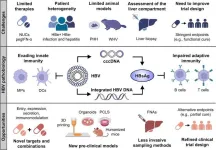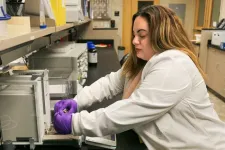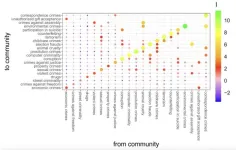(Press-News.org) PHILADELPHIA— The odds of prescribing the appropriate dose of statins—a medicine used to lower “bad” cholesterol levels—increased sixfold when automated referrals were made to pharmacy services, instead of relying on traditional prescribing methods, according to researchers at the Perelman School of Medicine at the University of Pennsylvania. More than 90 million people in the U.S. use statins, making it one of the most prescribed medications in the county. Despite their effectiveness in lowering cholesterol levels and the risk of cardiovascular diseases, previous studies have highlighted suboptimal prescribing trends. Typically, a doctor assesses a patient’s cardiovascular risk and determines whether a statin is needed, and at what dose. One reason for under-prescription of statins is that clinicians often do not have adequate time in the office to attend to patients’ preventive care needs. A workflow that automatically identifies patients who should be treated with a statin but are not, or are treated with too low a dose, and refers those patients to a pharmacist for initiation of appropriate statin therapy, is a promising way to ensure that cholesterol management is not overlooked.
Alexander C. Fanaroff, MD, MHS, an assistant professor of Cardiovascular Medicine, shared details of the clinical trial in a late-breaking science presentation today at the American Heart Association’s Scientific Sessions conference in Philadelphia, Pennsylvania (Abstract #23096).
The work of Fanaroff and his colleagues aimed to address the underutilization of statin therapy in U.S. adults who are candidates for such treatment. A large proportion of adults with or at high risk for cardiovascular disease do not receive statins at the recommended dose.
To bridge this gap, the research team conducted a cluster randomized clinical trial as part of the Penn Medicine Atherosclerotic Cardiovascular Disease Risk Reduction Initiative. The trial enrolled patients from ten primary care practices affiliated with the Penn Medicine Lancaster General Health System and explored the effects of automated referrals of eligible patients—those not already prescribed statins by a clinician— to a centralized pharmacy service. Pharmacists subsequently contacted appropriate patients, discussed their personalized risks and the benefits of statin initiation, and initiated therapy when appropriate. The primary goal was to assess the proportion of patients prescribed statins, and secondary outcomes included the proportion of prescribed statins at guideline recommended doses.
A total of 1,950 eligible patients were enrolled in the trial, with 975 assigned to the intervention arm—the automated referral group. The study revealed that 86.4 percent of eligible patients were not prescribed statins at all at baseline, and the rest were given inappropriately low doses. Patients in the intervention arm practices saw a significant increase in statin prescription rates, with 31.6 percent prescribed a statin, compared with 15.2 percent in usual care practices. Additionally, 24.8 percent of patients at intervention arm practices were prescribed a statin at the guideline-recommended dose during the study period, compared with 7.7 percent of patients at usual care practices.
“The findings suggest that automated referrals to centralized pharmacy services for lipid management are a game-changing strategy, drastically improving the odds of prescribing appropriate dose statins,” said Fanaroff.
The research was funded by a National Institutes of Health Clinical and Translational Science Award Grant (UL1TR001878).
###
Penn Medicine is one of the world’s leading academic medical centers, dedicated to the related missions of medical education, biomedical research, excellence in patient care, and community service. The organization consists of the University of Pennsylvania Health System and Penn’s Raymond and Ruth Perelman School of Medicine, founded in 1765 as the nation’s first medical school.
The Perelman School of Medicine is consistently among the nation's top recipients of funding from the National Institutes of Health, with $550 million awarded in the 2022 fiscal year. Home to a proud history of “firsts” in medicine, Penn Medicine teams have pioneered discoveries and innovations that have shaped modern medicine, including recent breakthroughs such as CAR T cell therapy for cancer and the mRNA technology used in COVID-19 vaccines.
The University of Pennsylvania Health System’s patient care facilities stretch from the Susquehanna River in Pennsylvania to the New Jersey shore. These include the Hospital of the University of Pennsylvania, Penn Presbyterian Medical Center, Chester County Hospital, Lancaster General Health, Penn Medicine Princeton Health, and Pennsylvania Hospital—the nation’s first hospital, founded in 1751. Additional facilities and enterprises include Good Shepherd Penn Partners, Penn Medicine at Home, Lancaster Behavioral Health Hospital, and Princeton House Behavioral Health, among others.
Penn Medicine is an $11.1 billion enterprise powered by more than 49,000 talented faculty and staff.
END
Though people often want to share good news as soon as they learn it, a study published by the American Psychological Association has found that keeping good news a secret before telling someone else could make people feel more energized and alive.
“Decades of research on secrecy suggest it is bad for our well-being, but this work has only examined keeping secrets that have negative implications for our lives. Is secrecy inherently bad for our well-being or do the negative effects of secrecy tend to stem from keeping negative secrets?” asked lead author Michael ...
Infants and toddlers may be psychologically wired to thrive with high levels of “sensitive care” and personal attention, according to a study conducted with contemporary hunter-gatherer societies.
Research led by an evolutionary anthropologist at Cambridge University found that hunter-gatherer infants receive attentive care and physical contact for about nine hours per day from up to 15 different caregivers.
Dr Nikhil Chaudhary says that, for the vast majority of our species’ evolutionary history, ...
The American Pediatric Society (APS) is pleased to announce eighty-four new members. Founded in 1888, the APS is North America's first and most prestigious academic pediatric organization. New members will be recognized during the APS Presidential Plenary at the Pediatric Academic Societies 2024 Meeting.
APS members are recognized child health leaders of extraordinary achievement who work together to shape the future of academic pediatrics. Current members nominate new members by recognizing individuals who have distinguished themselves as child health leaders, ...
Hepatitis B virus (HBV) is a significant public health problem, with over 296 million people chronically infected worldwide. Despite the availability of a safe and effective vaccine for over 40 years, HBV remains a leading cause of liver disease and death.
One of the main challenges to curing HBV is the unique biology of the virus. HBV replicates through a covalently closed circular DNA (cccDNA) intermediate integrated into the host genome. This makes it very difficult to eradicate the virus completely, even with effective antiviral therapy. Another challenge is the impaired immune response to HBV in chronically infected individuals. The virus has evolved several mechanisms to evade ...
White faces generated by artificial intelligence (AI) now appear more real than human faces, according to new research led by experts at The Australian National University (ANU).
In the study, more people thought AI-generated white faces were human than the faces of real people. The same wasn’t true for images of people of colour.
The reason for the discrepancy is that AI algorithms are trained disproportionately on white faces, Dr Amy Dawel, the senior author of the paper, said.
“If white AI faces are consistently perceived as more realistic, this technology could have serious implications for people of colour by ultimately reinforcing ...
The way ice forms is a lot more interesting than you think. This basic physical process, among the most common in nature, also remains somewhat mysterious despite decades of scientific scrutiny.
Now new research from the University of Utah, with Germany’s Max Plank Institute for Polymer Research and Idaho’s Boise State University, is shedding fresh light on the role of biological agents—produced by fungi of all things—in ice formation.
Contrary to what we have been taught in school, water won’t necessarily freeze at 0 degrees Celsius (32 degrees F) because of the energy barrier ...
For most patients, acute pain following a surgical procedure is a common and expected hurdle which is eventually cleared during recovery. However, there is a small but significant patient population that experiences chronic post-surgical pain that may linger for six months or longer.
Sex hormones (e.g., estrogen in females and testosterone in males) are generally regarded as contributors to post-surgical pain development and maintenance, and basal sex hormones are the range of sex hormones expected to be produced in a healthy individual at any point in time. When basal sex ...
Lithium-ion batteries (LIBs) are, by far, the most widely used type of rechargeable batteries, spanning numerous applications. These include consumer electronics, electric vehicles (e.g., Tesla cars), renewable energy systems, and spacecrafts. Although LIBs deliver the best performance in many aspects when compared to other rechargeable batteries, they have their fair share of disadvantages. Lithium is a rather scarce resource, and its price will rise quickly with its availability going down in the future. Moreover, lithium extraction and improperly discarded LIBs pose huge environmental challenges as the liquid electrolytes commonly used in them are toxic and ...
Penises are more prevalent in some lines of work than others. And for researchers who study biodiversity of insects, penises play a significant role in their daily workload – for good reason.
"Genitalia are the organs in insects that evolve to be different in every species. As such, they are often the best way to identify a species. That's why entomologists like us are always quick to examine insect genitalia when describing a species. The unique shape of each species’ genitals ensures that it can only reproduce with the same species," explains biologist Aslak Kappel Hansen of the ...
Researchers at the Complexity Science Hub have examined 1.2 million criminal incidents and developed an innovative method to identify patterns in criminal trajectories.
When it comes to preventing future crimes, it is essential to understand how past criminal behavior relates to future offenses. One key question is whether criminals tend to specialize in specific types of crimes or exhibit a generalist approach by engaging in a variety of illegal activities.
Despite the potential significance of systematically identifying patterns in criminal careers, especially in preventing ...





